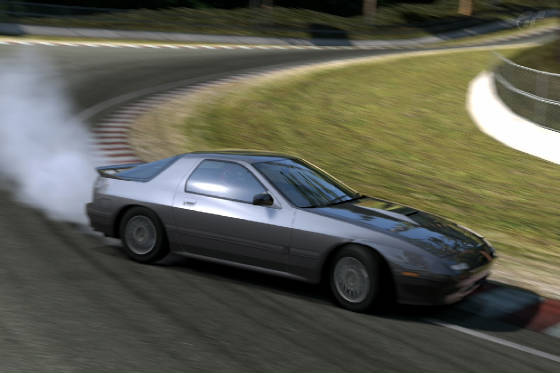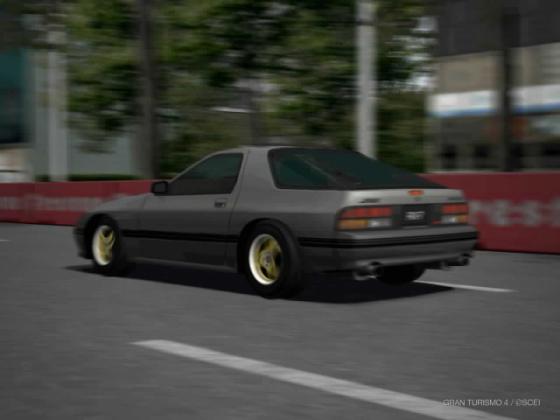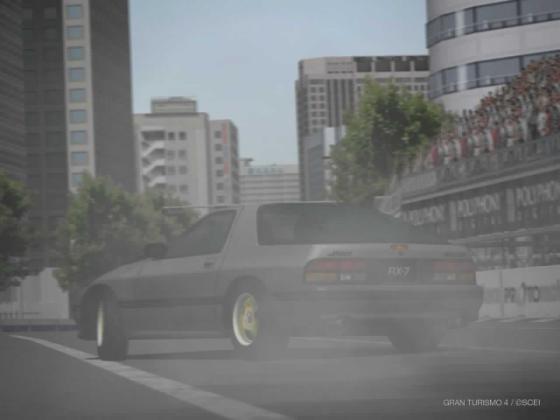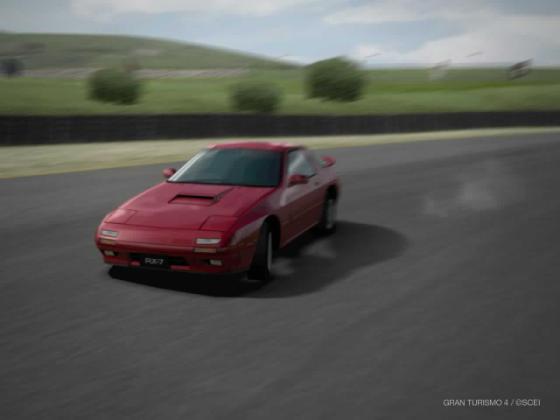|
---------------------SPECS-------------------
Years Represented: 1985-1990
Class: Sports Car
Type: Fastback Coupe
Country: Japan ````````````````````````````````` Host: GT1, 2, 3, 4 & 5
Price:
$9,670 (used GT2 price)
$32,300 (GT3 Infini III)
$8,700
(GT4: used '90 GT-X)
$9,193 (GT5, used '85 GT-Limited)
$15,684 (GT5, used
'90 GT-X)
$18,996 (GT5, used '90 Infini III)
GT4 Starting Mileage: 47,805.2
GT5 Starting Mileage: 46,140.5 (model not specified), 37,184.3 (Infini III)
Construction:
unit steel
Length: 179.7" // Width: 66.5" // Height: 50.0"
Wheelbase: 95.0"
Overhang: 6' 3"
F. Track: 57.1"
// R. Track: 56.7"
Ground Clear: 5.9"
Weight: 2,644-2,716 lbs. ('85 GT-Limited), 2,755 ('91 GT-X), 2,711 ('90 Infini
III)
Weight Dist: 48/52
Layout: Front Engine / Rear Drive
Tires: 205/60-15 (GT-Limited) 205/55R-16 (GT-X) 205/55
ZR 16 (Infini III)
Brakes: vented ciscs
F. Suspension: MacPherson struts / coils / anti-roll bar
R. Suspension: semi-trailing
arms / coils / anti-roll bar / toe-control links
*GT3, GT4, and GT5 cars all given oil changes
for specs & testing below.
*GT5 cars did not have engine rebuild performed, but did get oil changed.
Specs & testing below for Infini III
Engine: 1.3 liter Dual Rotary
Construction: alumium alloy
Aspiration: Intercooled Turbo
Fuel System: EFi
Compression Ratio: 9.0:1
GT2 Tested HP: 212 @ 6,500 rpm
GT2 Tstd Torque: 190 @ 3,500
rpm
GT3 Tested HP: 219 @ 6,500 rpm
GT3 Tstd Torque: 208 @ 4,000
rpm
GT4 Final bhp: 203 @ 6,500 rpm
GT4 Final trqe: 198 @ 3,500 rpm
GT5 Final BHP: 205 @ 6,500 rpm
GT5
Final trqe: 199 @ 4,000 rpm
Lbs per HP: 13.45 (GT2), 12.07 (GT3), 13.57 (GT4--GT-X), 13.22 (GT5--Infini III)
Hp per Liter: 161.5 (GT2)
167.4 (GT3), 155.2 (GT4--GT-X), 156.7 (GT5--Infini III)
Cr. per HP: $45.61 (GT2) $147.49 (GT3), $42.86 (GT4)
Transmission: 5-speed manual
Differential: limited slip
GT2 0-60 mph: 7.5 seconds
GT3 0-60 mph: 7.150 seconds
GT4 0-60 mph: 6.750 seconds (GTX)
GT5 0-60
mph: 7.017 seconds (GTX, pre Test Track X)
GT5 0-60 mph: 7.100 seconds (Infini III, TTX)
GT2 0-100 mph:
18.5 seconds
GT3 0-100 mph: 17.700 seconds
GT4 0-100 mph: 17.233 seconds
GT5 0-100 mph: 17.300 seconds
(GTX) GT5 0-100 mph: 17.376 seconds (Infini III, TTX)
GT2 & 3: no test done for 0-150 mph
GT4
0-150 mph: 1:04.850 seconds
GT5 0-150 mph: 1:37.266 seconds (GTX @ Daytona) GT5 0-150 mph: 1:10.083
seconds (Infini III, TTX)
GT2 400 M: 15.576 (mph not specified)
GT3 400 M: 15.668 @ 94.6 mph
GT4
400 M: 15.465 @ 95 mph GT5 400 M: 15.447 @ 94 mph (Infini III)
GT2
1 KM: 27.721 @ 123 mph
GT3 1 KM: 27.669 @ 122.8 mph GT4 1 KM: 27.708
@ 122 mph GT5 1 KM: 27.669 @ 121 mph (Infini III) Test
Track Lap: GT2: N/A GT3: 2:34.715 GT4: 2:31.735 GT5: 1:00.428 (Daytona,
GT-X?) GT5: 1:01.177 (Daytona, Infini III) 100-zero mph: GT2: no
test performed GT3: no test performed GT4: 3.82 seconds GT5: 5.433 seconds (GT-X?) GT5:
5.600 (Infini III) Top Gear RPM @ 60 mph: 2,750 (model not specified). GT2
Top Speed: 162 @ 7,400 rpm
GT3 Top speed at Redline
1st: 36.5 mph
2nd: 63.6 mph
3rd: @95 mph
4th: 133.6 mph
5th: 159.3
mph @ 8,100 mph
GT4 Top Speed at Redline
1st: 36 mph
2nd: 65 mph
3rd: 95 mph
4th: 133 mph
5th: 155.14
mph @ 7,100 rpm
```````151.xx mph @ 7,000 rpm (GT5, model not specified)
GT5 Top
Speed at Redline (Infini III) 1st: 33.2 mph 2nd: 55.3 mph 3rd: 81.0 mph 4th: 115.1
mph 5th: 153.9 mph @ 7,100 rpm

------------------------EXTERIOR----------------------
It was surprising to me how much fun an RX-7 could be. I never got around to racing them
in GT1 before unrelenting desire made me start delving into GT2. I figured the RX-7 would offer nothing new--nothing I hadn't
already seen after racing the Viper, Camaro, Corvette, NSX, Cerbera, Silvia, 240SX, etc. So when I finally got behind the
wheel (actually when I finally got behind the dual-shock controller ha ha) of a red Infini III, I was hooked.
The
Savannah RX-7, otherwise known as the "FC series", appeared towards the end of the '80s. It was only known as "Savannah" in
Asian countries; outside of Japan the car was given other names...usually just "RX-7". The FC series was replaced just
after the Miata/MX-5 hit the market and Savannah sales were starting to slow.
It is well-known that Mazda looked to
Porsche's 924 and 944 models for inspiration on the FC's design, so that what we wind up with here is a sleek designed front
with hide-away headlamps, and a bumper which molds into the fenders and hood (unlike the FB, which had a front bumper
which looks seperate from the rest of the car). The rear is bulbous, with a functional glass notch, all of which is consistent
with Porsche's strongest front-engine/rear-drive sellers of the mid to late-80s.
Various versions
of the RX-7 appear in our games: the GT-X, GT Limited, Type R, Infini III, and Cabriolet are just a few names that appear,
and each of these included various options in real-life. GT3 only has the famous Infini III for sale, which was the top-line
model. The Infini III had a huge list of extras (badging, slight tweaks, etc.) but all we need to know is that it was the
lightest and fastest of all. For its day, it was one of the top Japanese sports cars one could buy, yet notice that when compared
to other RX-7 models, it is not that much lighter or that much faster. We are not comparing an ordinary NSX to its Type
S Zero or Type R cousins here!
In real-life, there were also some naturally-aspirated
cars, but we only get the turbocharged ones. This is because only turbocharged RX-7s were sold in Japan. Poor guys. Outside
of Japan, Mazda created non-turbo models to get around extra taxes, insurance rates, and such placed on these faster
models in America and Europe.
After 1992, the RX-7 FD (3rd generation) was unleashed. The FD is a sports car yet barely;
it feels like more confident than the FC at most tracks, even fresh from the dealer/stock. In comparison, earlier FC cars
have sporty looks, yet don't feel as competent in races. They are more challenging to drive, and hey...I'm always
up for a challenge.
For those who are experienced with racing games, the RX-7 is a great first buy...a great way to start
GT1, GT2, GT4, or GT5, assuming you can find one from Day 1. Priced below $10,000 from the used car lot, one can buy one and
immediately begin winning, even before modifications are in place.
In GT3, one can no longer buy
an FC RX-7 from Day 1, because it now costs just over $32,000! Is this a reflection
of reality? Perhaps. Remember that the Infini III (the only RX-7 from the FC generation) was Mazda's top model. As Gran
Turismo and other racing games (not to mention amateur racing) has peaked our interest, the real-life price of many cars has
risen like a vampire at dusk. But I somehow seriously doubt there are any $32,000 RX-7s out there, unless they're heavily
customized or something.
A trip to several car-selling websites and my suspicions were confirmed. I have yet to see
an FC-series RX-7 (even with fairly low miles) selling for much over $10,000, if that. So in this respect, GT4 and 5 have
prices that are much more realistic. An Infini III in GT5, for instance, costs more than any other RX-7s from its era, yet
at just over $18,000, it is nowhere near GT3's inflated price.
Perhaps PD was trying to use the Infini III's
"new" price tag, "new" in 1990, that is. As a new car back in the early '90s, these top RX-7s did indeed sell for over
$30,000, according to a reputable Japanese car specs website I visited. But they would not have held such a value in 1999-2001
when GT3 was in development.
Beginners will have problems with the FC-generation RX-7 because it's fast and dodgy, but anyone with
experience should be able to handle one, pwn, and command. We can buy race-kits for any of these cars in GT1
or 2, which help extend their careers a bit. There is rarely a shortage of used RX-7s in GT1, 2, or 4, although in GT5 it
may take a while to find one.
----------------ENGINE / DRIVETRAIN----------------
The RX-7 features Mazda's famous dual rotary engine. Let's
learn a few facts about it.
The rotary was invented in the late '50s by mad scientist Dr. Felix Wankel, a German Engineer. You might
think Dr. Wankel was one of those men with crazy hair you see running around a lab... beakers and smoke everywhere; but in
reality he was just a boring guy with one hell of an idea. There are a couple interesting things, though. I've read that
Felix never attended college, and that in the 1920s was imprisoned because of a disagreement with Hitler. He couldn't have
been that boring, then.
We could go on and on about Felix's story (as I'm tempted to after reading about
him), but let's not get off topic. All we need to know is that he invented the rotary. And barely lived to see the
car which made it most famous: the Mazda RX-7.
The rotary had been developed in the fifties. In experimental situations, Wankel had some of them spinning
much faster than Mazda rotaries ever have. Perhaps these super-fast rotaries (we're talkin' well beyond 20,000 rpms) proved
to lack durability, which is why in Mazdas revs top off around 8,000. After its creation, I believe Mercedes-Benz was
the first to try actual rotary-engine tests in prototype cars, but NSU was the first car maker to use rotaries
in production. Unfortunately for NSU, a German carmaker now out of business, the rotary had plenty of problems!
Other car makers have dabbled with rotaries since: GM, Suzuki, Yanmar Diesel, and OMC have all had a go
with their versions, but only Mazda has used it religiously to this day. There's no question that Mazda's input has helped
to develop the rotary, which in the '60s and '70s had all kinds of issues (compression loss, worn tips, etc.) before becoming
practical.
In our games, throttling the engine creates a unique sound, reminiscent of a vacuum cleaner. Its
torque curve is also odd, as well, since the engine is basically a couple of triangular-shaped spinning tops in a round casing.
These RX-7s have inter-cooled turbos, and are reasonably fast even before mods are in place. Though it's
not the speediest from its time, you have to admire that this 212 hp engine is only 1.3 liters, and puts out an amazing 161.5
hp per liter in specific output!!! That's tech-talk for: small engine / lots of go. Early rotaries made nowhere near
this kind of might.
In any game except maybe GT3, modifications to the drivetrain, engine, and turbo can begin immediately
with all the races you'll win, since these cars can be found so cheaply. GT3's initial cost (32,000 cr.) might limit this,
you see. An RX-7 with a Stage 1 turbo, sports intercooler, close-ratio gearing, single-plate clutch, and light flywheel
will take you many miles and win many races, though these cars are limited since they can't enter some of the B-license
races in the 2nd game. In GT1, a few spot races can be won, but you'll soon need at least some light mods to take on slicker
autos such as the NSX.
But parts are cheap. Not a problem. Finally, I have to say that in GT3, an RX-7 (any
RX-7) will blow thru the Beginner's League with few (if any) mods, so only during the Amateurs will it start
to need some extra turbo power.
The car'll only need a racing tranny for xtreme races like the Tuned Turbo cup at the Test Track. Rest
of the time, stock or close gearing can be used, depending where the car is raced. I've never needed super-close (semi-racing)
gears, but I bought them anyway. Actually, this super-short gearbox comes in handy for some off-road events.
In GT2, when fully modified, these cars make just below 400 horses, and in GT4, there
is slightly more (433 bhp @ 6,500 rpm with 334 foot-pounds via a Stage 3 turbo). GT5
rates 420 hp @ 7,700 rpm with 322 foot-pounds @ 5,400 for a GTX, while the top-line Infini
III rated slightly more at 429 horses with 323 foot-pounds. Once we're playing with this much power these sporty cars start
to become more problematic, as we'll see. In GT1 or GT3: A-Spec, the '90 RX-7 starts off with issues...

--------------------CHASSIS / HANDLING----------------
Since this car is in all GT games, it makes a great evolutionary case-study. I'll lose
a few friends here after I say this but here goes: in our games, the FC-series RX-7's handling doesn't rate very high
in my book...in some situations it's even lower than the handling of a C4 Camaro. Let me explain.
• GT1:
Seriously. Take a drive in this thing around ...say...Trail Mountain. Check out that "brake-dive-jacknife"
dance it does as it enters corners. Even with a full-custom suspension in place, the '90 RX-7 still wants a party and usually
gets one, unless you're super-early with those brakes. The front-end is way too grippy, and the rear gets way too loose even
under MILD conditions. It just drives way unrealistic in the first game (sorry TMM) and makes the RX-7 not a choice for beginners,
or even many intermediates. Its rare you'll hear me say this, but in this game some understeer would actually be welcome
here. At least it would give a bit of balance. Driving this car into a corner, it displays all the grace of a hammer striking
a chisel at times.
• GT2:
Completely different story here. Even before the car has a limited-slip in place, and is still totally
stock, you may notice the RX-7 in the 2nd game is a lot more manageable. In GT1, we won't need to try drifting...the
car does it for us! We'd better learn quick. But in GT2, things are tighter. The RX-7/FC may get a little soupy
at times, dipping and swaying in those corners, but only at the most extreme levels of power does this model really start
to lose it.
GT3: A-spec:
Again, the FC series (stock or modified) feels looser, but not as unpredictable as in the
first game. In GT3, our car is constantly oversteering. Sometimes it's a light rear-end dance, at other times
the driver'll need to take on some more severe measures. In any event, the sporty rear acts a bit lazy thru corners and usually
doesn't want to commit to the same racing lines we do, which is great for drifters but won't inspire corner-confidence
the way later FD-series cars do once they're actually racing on a serious level. Even when better MazdaSpeed parts are
in place, this car just doesn't feel as racy as later RX-7s. It can be tamed a bit, yet always feels a bit clumsy.
Here's another note of interest. With the 2nd generation (FC) RX-7s, Mazda tried to introduce
4-wheel steering, but it was apparently too problematic. Instead, the rear wheels feature a passive steering
system called DTSS (Dynamic Toe Steering System) that turns them in the same direction as the front wheels, but only slightly
so.
In any event, the '89 and '90 RX-7s are still a great buy in this game, even with their inflated prices.
These are best for those who are skilled, but in some situations, even the less skillful can excel.
GT4
Now in this game, the FC feels similar to the way it felt in GT3, except all the traits experienced from the third
game are now muted to about half with one exception (guess): understeer. Thankfully, this understeer isn't
too great, and is balanced with other traits.
At low-speed, the front-end is displaying a lot of grippyness
(rather than understeer). And the rear still has the ability to get loose, but it's not quite as fun and as in the 3rd
game. There's stilll plenty of power-oversteer in this car, which makes the RX-7 (again) a drifter's choice, but
these cars aren't nearly as accessible for inexperienced players so far as drifting goes. But this can be said: if you're
looking to learn how to drift in GT4, the FC series is still a great choice to start with.
Braking is confident
in this game until we need to bring down from high speed, and need to employ steering at the same time. I'm
not sure if it's that passive toe-control rear-steering, but in GT4 the rear has a habit of getting squirrely under trail-brake
maneuvers. This is alot of fun if you know what you're doing, but can be frustrating if you don't.
All of this
can be tamed with a differential and a rigidity refresh, of course. The good news is, a differential won't be
needed to tame wheelspin under power till the car has at least Stage 3 or 5 power. Before this, the rear of
these FCs only gets loose, but rarely will the inside-rear wheel overcook under power as it corners. Real-life turbocharged RX-7s had
limited-slips while they were stock, and PD obviously modeled this in GT4, so we'll only need to buy aftermarket
parts to enhance stability if so desired.
GT5
...re-introduces
us back to the way this car should be handling. The front-end feels mostly confident with minimal understeer (unless the driver
doesn't know what braking zones are), and the rear has that mildly sloppy feel, just as it did in GT3. The fun factor
is back! Oversteer! Drifting! Slippy/slideyness! Where were you fun factor? Oh, how we've missed you!
Since this
car rides on soft radial tires from the start, this is how I drove it initially. But even on Sport tires the RX-7 can still
break traction if that's what you're after. Watching my initial drive around Trial Mountain in my charcoal gray sports car,
I was pleasantly happy to see myself countersteering again. The car was just mildly breaking traction
as I pushed it to its limits. Yes! Lots of fun.
During actual races, however, sometimes we must adopt a strategy that
kills a lot of this so-called "fun". Tuning, in other words. It's a good idea to mess around with either of the Sport suspensions
in this game, if the RX-7 is being placed into a situation where its handling is keeping it from staying ahead of other cars.
Online racing also often demands we really get this car handling a little more professionally, assuming we're not entering
our RX-7 into one of the many drifting contests happening nowadays.
But overall, whichever game you've
got, the RX-7 is a kick-ass automobile that drives wild, can't always be trusted, but will garner plenty of wins.

-------------------------PROS------------------------
1). Rotary engine feels race-ready with a highish redline. It's putting out
a lot of power yet is just 1.3 liters. This is due heavily from Mazda's real-life racing development.
2). Affordable in any game except GT3. A great car for intermediates and pros. The RX-7 FC series
is on every "First Car to Start the Game With" list.
3). Stock gearing allows a perfect combination of speed and acceleration.
4). Weight distribution is near-balanced and often provides neutral handling found in real sports
cars....at least in theory. We can experience this in GT2 and GT5 more than the others.
5). Great car for drifters. Commandable, compliable. This is true in any game except GT1, in which
the FC tends to drift US instead of the other way around.
6). Race-kit available in GT1 or 2...really looks killer in the first game (check out the green rims
and the lettering on the tires).
7). In any game, three levels of intercooled turbo available. GT4 includes a 4th turbo kit (Stage
5 can be bought after-market from one of the tuning shops). GT5 has no seperate intercoolers, but there are additional
parts and services we can employ not found in earlier games.
8). Not too heavy of a car, and not light
enough to introduce stability-loss issues over bumps.
9). Not the most handsome of designs, and Mazda aped Porsche
with its design, but certainly the FC is an eye-catcher.
----------------------CONS---------------------
1). Oversteer. Are you familiar with this concept? If not,
the RX-7 is ready to teach you all about it. Depending which game you've got, oversteer seperates the wannabes from the
pros eventually.
2). And in GT4 we have understeer (with barely any useful oversteer), which sometimes ruins the RX-7/FC
experience...making the car not as fun to drive as in earlier games, especially for those looking to maintain some drifts.
3). In GT2, the 212 hp engine is a bit too powerful; horsepower limits won't allow one to enter an
FC into most B-license GT races.
4). Ultimate power is limited--an LM series or perhaps a late-model FD (like the Spirit R Type
A) will be needed to reach the highest plateaus of racing.
5). In GT2 with full power of just 397 hp, super-soft slicks, racing gear, and perhaps a racing body
may be needed. Ouch, that's a lot of money. Otherwise, this Mazda starts getting rather clumsy. GT1, it starts off
clumsy. In GT3, GT4, and 5 the RX-7 sort of agrees with us...but sort of doesn't. Not a car for n00by players, in other
words.
6). Lacking in torque, yet the engine has too much bite after 4,000 rpms once serious upgrades
are in place, which lashes out as the rear gets loose during cornering. At times like these, the driver will need
to moderate the throttle or face a drift-death. Again, not good for beginners...and too bad a lot of beginners choose RX-7s.
I know this because a seemingly un-ending derth of newbs stream thru online bulletin boards wondering "how do u drft?"
7). The wedge front-end and giant hood scoop don't combine to make a pretty car. Most would agree
that 1st gen RX7s as well as later FD series cars just aren't as ugly or goofy-looking.
8). GT3: at $32,000, the Infini III of this game isn't exactly priced to move like it is in other games. 9). And in GT5, this one is rare enough to get frustrating to find, at
times.
Originally Published: June 9, 2004
Heavily Edited: October 16, 2006
Edited
for GT4 content: February 28, 2009
Edited for GT5 content: May 7, 2011
Edited for Infini III testing
and minor text changes: May 18, 2014
|





